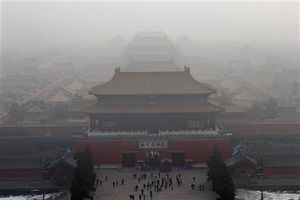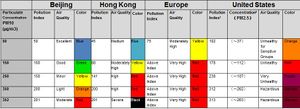GL'Herogan (talk | contribs) mNo edit summary Tag: n |
GL'Herogan (talk | contribs) No edit summary |
||
| Line 1: | Line 1: | ||
{{JMC330inprogress|May 15, 2013}} | {{JMC330inprogress|May 15, 2013}} | ||
In recent years '''China's Air Quality''' has caused public concern and outcry. Though municipal officials in Beijing have declared the 14th year of improving air quality <ref>"Beijing air quality improves for 14th consecutive year", Xinhau, 2012-12-31</ref> many are | In recent years '''China's Air Quality''' has caused public concern and outcry. Due to the severity of the pollution Surgical masks are a common sight in cities and smog surrounds buildings. Though municipal officials in Beijing have declared the 14th year of improving air quality in 2012 <ref>"Beijing air quality improves for 14th consecutive year", Xinhau, 2012-12-31</ref> many are still unsatisfied with the current conditions. Much in part to the government declaring some statistics 'state secrets' inaccessible to the public such as the case of attorney Dong Zhengwei attempt at receiving a 2006-2010 national study on soil samples <ref>"In China, public anger over secrecy on environment", Reuters, 3-10-2013</ref> | ||
[[Image:Forbidden City Jan. 13 2013.jpg|thumb|Smog in the Forbidden City Jan. 13 2013]] | [[Image:Forbidden City Jan. 13 2013.jpg|thumb|Smog in the Forbidden City Jan. 13 2013]] | ||
==Warning Signs== | |||
One of the first globally noted indicators was the establishment of an air monitoring system in the United States Embassy in Beijing in 2008. Not only was this a system that provided uncensored reports of hourly air quality via Twitter but it was also the first published reports of of PM2.5 measurement (PM stands for particulate matter those less than 2.5 micrometers in diameter are referred to as PM2.5. The size category of PM2.5 consists of particles small enough to cause breathing problems and get deep into lungs <ref>United States EPA Fine Particle (PM2.5) Designations</ref>. Until early 2012 the Chinese government had only released PM10 measurements which resulted in a rating of Excellent or Good 80% of the time for 2010-2011 on their scale of PM Quality. | |||
[[Image:PM concentration index.jpg|thumb|Comparison of PM Standards <ref> US Beijing Twitter Analysis, Steven Q Andrews Chinadialogue http://www.chinadialogue.net/article/show/single/en/4661-Beijing-s-hazardous-blue-sky</ref>]] During January 2013 the Beijing Embassy Twitter posted an hourly result of 755 on a scale of 500 on the United States EPA Air Quality Index (AQI). In contrast the new Chinese PM2.5 system implemented in 2012 doesn't measure over 500. | |||
==Government Response== | |||
The Beijing Embassy Twitter has caused some outrage in the Chinese Government since it's implication in 2008. Chinese Foreign Ministry official Wang Shu’ai prompted the embassy to stop the Twitterfeed in July 2009 citing that “is not only confusing but also insulting,” at a meeting with US delegates <ref>09BEIJING1945, EMBASSY AIR QUALITY TWEETS SAID TO "CONFUSE" CHINESE, Wikileaks, http://wikileaks.org/cable/2009/07/09BEIJING1945.html</ref> | |||
==Future Outcomes== | |||
<references/> | <references/> | ||
[[Category:JMC330 International Mass Communication]] | [[Category:JMC330 International Mass Communication]] | ||
Revision as of 22:12, 5 April 2013
In recent years China's Air Quality has caused public concern and outcry. Due to the severity of the pollution Surgical masks are a common sight in cities and smog surrounds buildings. Though municipal officials in Beijing have declared the 14th year of improving air quality in 2012 [1] many are still unsatisfied with the current conditions. Much in part to the government declaring some statistics 'state secrets' inaccessible to the public such as the case of attorney Dong Zhengwei attempt at receiving a 2006-2010 national study on soil samples [2]

Warning Signs
One of the first globally noted indicators was the establishment of an air monitoring system in the United States Embassy in Beijing in 2008. Not only was this a system that provided uncensored reports of hourly air quality via Twitter but it was also the first published reports of of PM2.5 measurement (PM stands for particulate matter those less than 2.5 micrometers in diameter are referred to as PM2.5. The size category of PM2.5 consists of particles small enough to cause breathing problems and get deep into lungs [3]. Until early 2012 the Chinese government had only released PM10 measurements which resulted in a rating of Excellent or Good 80% of the time for 2010-2011 on their scale of PM Quality.

During January 2013 the Beijing Embassy Twitter posted an hourly result of 755 on a scale of 500 on the United States EPA Air Quality Index (AQI). In contrast the new Chinese PM2.5 system implemented in 2012 doesn't measure over 500.
Government Response
The Beijing Embassy Twitter has caused some outrage in the Chinese Government since it's implication in 2008. Chinese Foreign Ministry official Wang Shu’ai prompted the embassy to stop the Twitterfeed in July 2009 citing that “is not only confusing but also insulting,” at a meeting with US delegates [5]
Future Outcomes
- ↑ "Beijing air quality improves for 14th consecutive year", Xinhau, 2012-12-31
- ↑ "In China, public anger over secrecy on environment", Reuters, 3-10-2013
- ↑ United States EPA Fine Particle (PM2.5) Designations
- ↑ US Beijing Twitter Analysis, Steven Q Andrews Chinadialogue http://www.chinadialogue.net/article/show/single/en/4661-Beijing-s-hazardous-blue-sky
- ↑ 09BEIJING1945, EMBASSY AIR QUALITY TWEETS SAID TO "CONFUSE" CHINESE, Wikileaks, http://wikileaks.org/cable/2009/07/09BEIJING1945.html